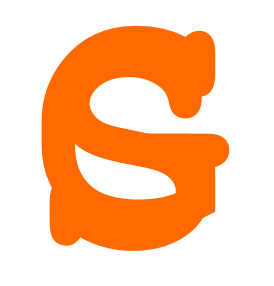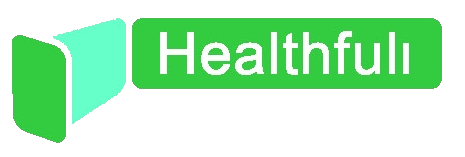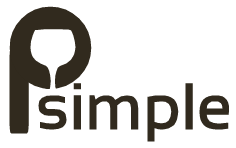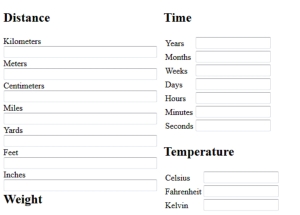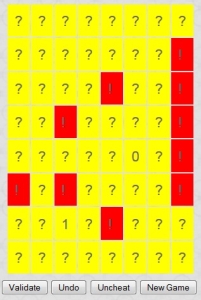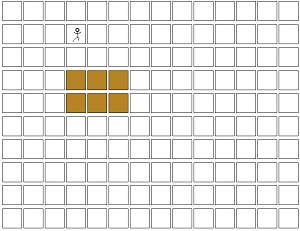Aerospace Portfolio
2022 February, Iron Ring Technologies LLC / Intuitive Machines
Synthetic Imagery for Lunar Optical Navigation
Poster presentation at 2022 American Astronautical Society (AAS) GN&C conference on synthetic imagery of lunar terrain with our optical navigation cameras using PANGU and Unreal to test out our optical nav algorithms.
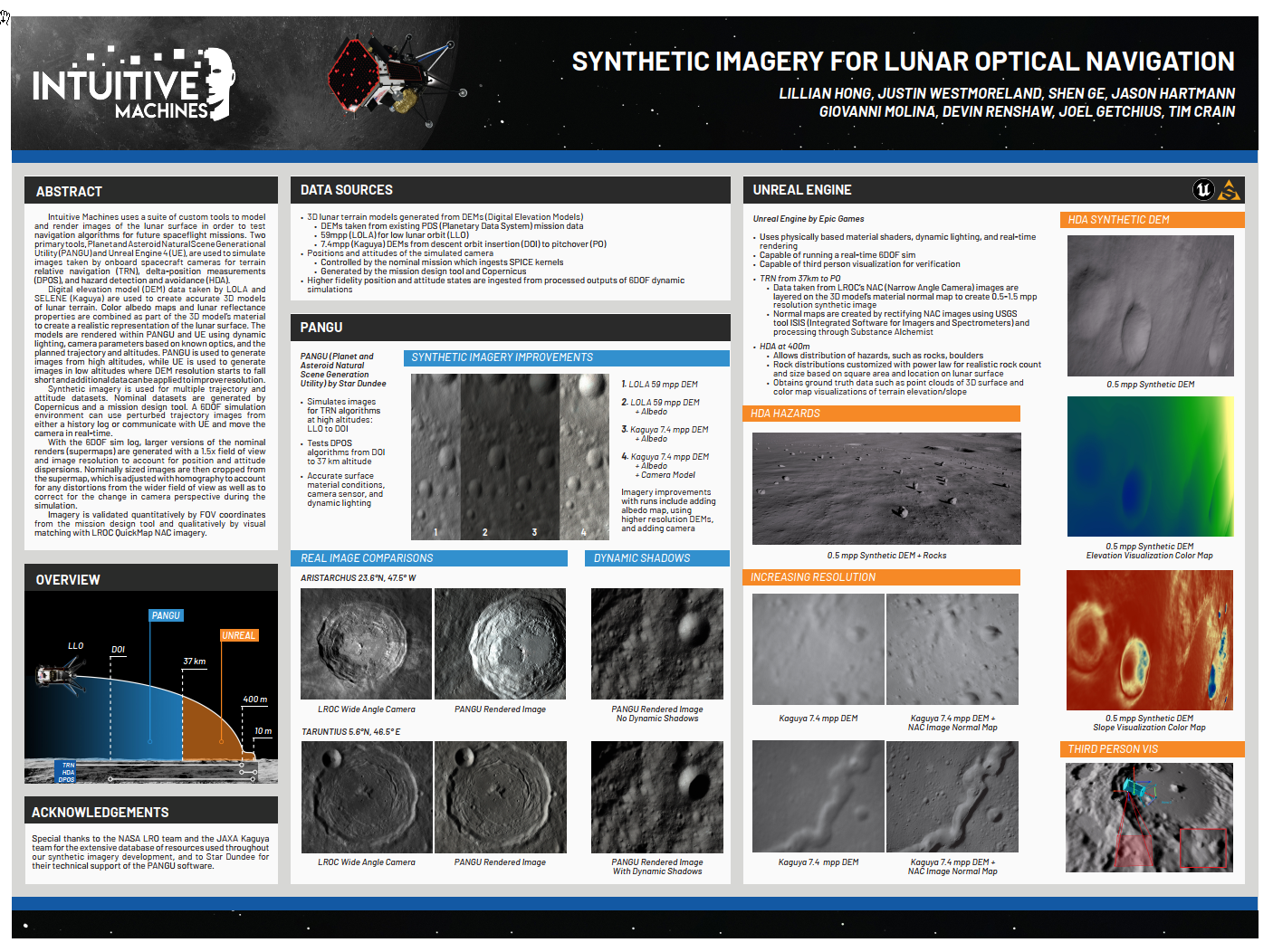
2022 February, Iron Ring Technologies LLC / Intuitive Machines
HAZARD DETECTION AND AVOIDANCE FOR THE NOVA-C LANDER
Paper presented at the 2022 American Astronautical Society (AAS) GN&C conference on hazard detection avoidance (HDA) navigation algorithm to identify the safest landing site for the Nova-C lunar lander. This paper is fairly high level and should be understandable to anyone with a basic mathematics and aerospace background.
2021 March, Iron Ring Technologies LLC / Intuitive Machines
Generating Synthetic Imagery for TRN Using PANGU and Unreal Engine
Poster presentation at the Lunar Surface Innovation Consortium (LSIC) Terrain Relative Navigation Conference on using synthetic imagery generated by PANGU and Unreal for testing our terrain relative navigation algorithms.
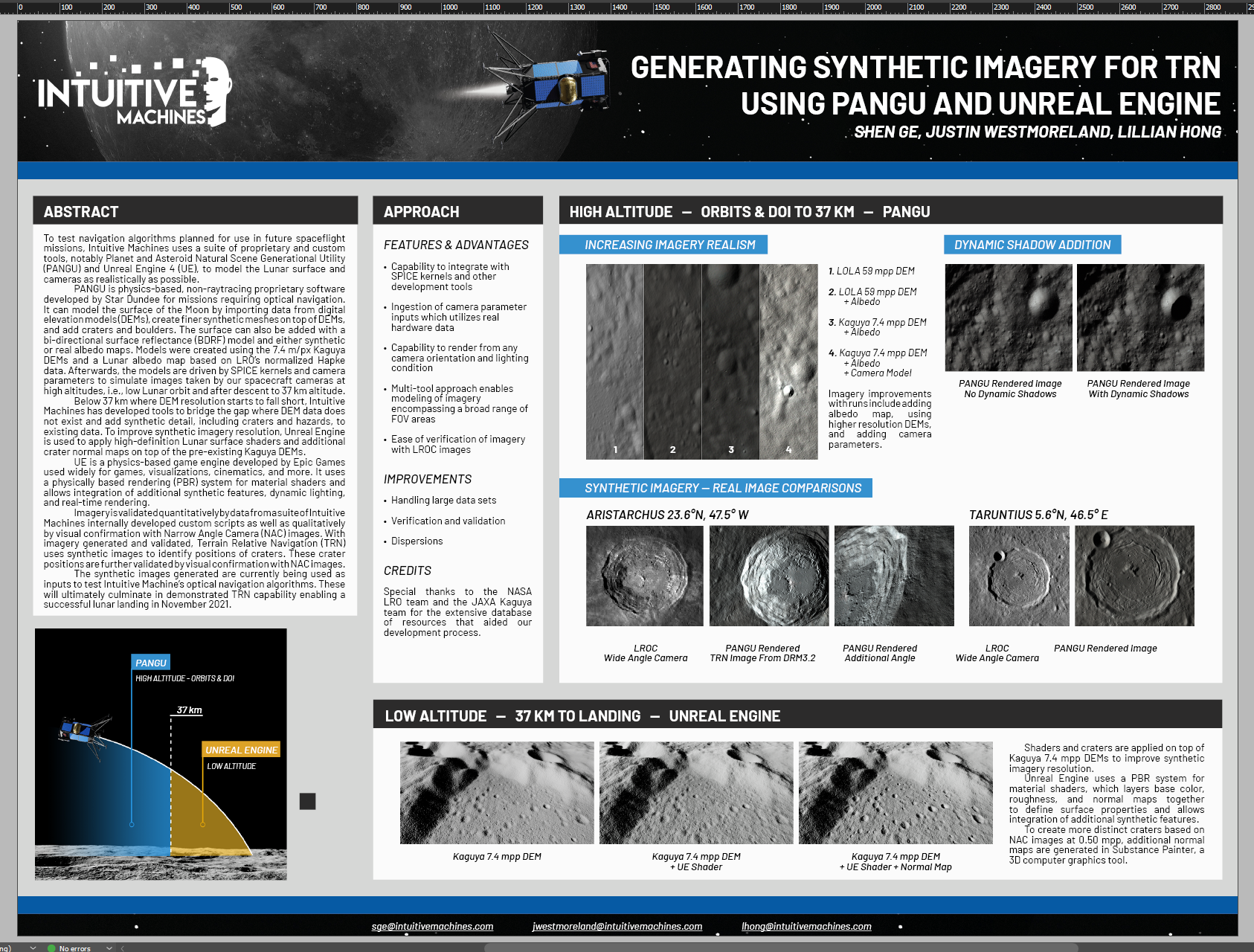
2016 May, ECAPS LLC Researcher with Adelante Sciences CEO Yvonne Vigue-Rodi
Feasibility of Transferring On-orbit Components of the International Space Station for Solar System Exploration
This latest work presented at the 2016 AIAA Houston Annual Technical Symposium (ATS) addressed the potential of repurposing the International Space Station (ISS) as a lunar space station at its end-of-life in 2024. This is an overview of the mission concept which is to break apart components of the American portion of the ISS and launch each component to a low lunar orbit (LLO) where it would be then reassembled. Three types of trajectories and three types of engines were considered with masses calculated. Future work is underway in the form of an upcoming paper with details addressing at least the following:
- How the spacecraft can leave in a trajectory that will both quickly leave the orbital debris field around LEO without significant risk AND not requiring a propulsion system which would need an exorbitant amount of fuel.
- How to attach solar panels to each ISS module. Roll-out solar array (ROSA) under development by ATK contracted by NASA is one possibility.
- How to protect each ISS module from radiation in an environment outside of the Van Allen belts so that future astronauts would be able to inhabit the lunar station.
2014 August, ECAPS LLC Researcher with ECAPS LLC Researcher Neha Satak
An Improved Economic Model for Asteroid Mining
Presentation: Economics of Asteroid Mining
Working with researcher and business partner Neha Satak, we conducted an extensive study on the technical feasibility and the economics involved in asteroid mining. We presented our research at the AIAA Houston Annual Technical Symposium on May 17, 2013 and the AIAA Houston's Lunch and Learn in August 2014. Asteroid mining is drawing increasing interest in 2012 with the establishment of two space companies publicly declaring their common intention of mining asteroids. However, the economics of asteroid mining is barely developed which raises questions on how these companies and future startups will attract enough investment for such a mammoth project. In economics, a net present value that is positive indicates a positive return on a project. No significant additions have been made to Mark Sonter's net present value equation for asteroid mining since he wrote his thesis in 1997. Building upon Sonter's equation, we introduced new variables to cover the gaps and resolves uncertainties in the previous equation.
2014 June, ECAPS LLC Project Manager
Surface Albedo Treatment System - Deflecting Near Earth Asteroids with Paint
The latest paper published at the 2nd SPACE Conference in Orlando, Florida on June 20-21, 2014. This has been a year and half's of work conducted at ECAPS LLC, the space research company I co-founded. This work continues that of which I started as a graduate student at Texas A&M University. I transitioned from the role of a simulation engineer to that of a project manager for the project. Using a modified industrial powder gun to spray paint the surface of an asteroid with powder (otherwise known as albedo change particles), the albedo (reflectivity) of the asteroid can be modified which changes the amount of photons emitted on each side of the surface. By focusing on the particular asteroid Apophis, we designed an entire mission through simulations and ground experiments which uses Apophis as the test case scenario for our surface albedo treatment system (SATS) payload. We go into details of particular experimental design parameters, experimental setup, positions and velocities of albedo change particles (ACPs), albedo change observed, and the uncertainty of the asteroid before and after albedo change, we construct a coherent picture of the entirety of the design of our SATS payload.
2013 September, ECAPS LLC Project Manager
Space Moving Object and Transient Event Search System (SMOTESS) for Detecting Near-Earth Asteroids NASA Proposal with
Roy Tucker, Hyerim Kim, Neha Satak, and Klaus Smit
Working with Texas A&M University and with advice from optical engineer and astronomer Roy Tucker, I led a team of ECAPS LLC engineers to propose a cost-effective telescope in a Venus-like orbit to detect near earth asteroids. The SMOTESS instrument is a configuration of four small telescopes (one for redundancy). It does not require accurate attitude tracking as in typical space telescope designs since it uses the scan mode imaging technique which has been demonstrated on-ground in the existing heritage system MOTESS. The MOTESS has detected numerous NEAs, with objects ranging from asteroids with diameters about 300 meters such as 1997 MW1 down to asteroids with diameters of tens of meters such as 2003 UY12.
Note: Due to concerns of privacy from my partners, I have taken the paper down from the website.
2012 May, Lead Proposal Writer
New Space Business Plan Competition Executive Summary with Neha Satak
I created the business concept called Spacecraft Design Platform and wrote an executive summary of a business plan called Citizen Spacecraft Design Platform for 2012 New Space Business Plan Competition in a team with two other engineers. The Spacecraft Design Platform (SDP) is envisioned to be a web application which allows team collaboration on space design projects from start to finish. We conducted an initial market survey. The survey result showed that for 77% organizations, 15% project timeline is required for payload development viz a viz satellite/spacecraft design and development. The data emerged highlighted that more than 75% of these organizations don’t have any design integration software. Those organizations which do use either customized or off the shelf product, majority of them reported that their software does not enable them to see the effects of changing design parameters on other parts of the design.
2011 November, Lead Proposal Writer
100 Year Starship DARPA Proposal
I led in writing 2011’s DARPA Proposal for 100 Year Starship in a team with six other engineers including two aerospace engineers, an optical engineer, and three graduate students. We envisioned an international university dedicated to developing space research and education. Exploration projects will be developed in advanced propulsion research and life support system development which are the two most important areas for an extended interstellar journey to succeed. The 100YSS Org will not be a university but a research institution conducting independent research with possible collaboration from outside industry or universities. Every year, excelling students from universities will be taken by the 100YSS Org as interns. Similarly, every year, several students who have worked at the 100YSS Org will be hired by the 100YSS Org to invigorate new energy and insights as well as to grow the organization. Though we were not funded, we decided to launch the Scientific Preparatory Academy for Cosmic Explorers anyway.
2011 September, Lead Proposal Writer
European Satellite Navigation Competition with
Neha Satak, Tejal Thakore, and Anish Bhattacharya
I led in writing and presenting technical and business plans for the 2011 European Satellite Navigation Competition pitching two ideas (water sensor device and travel smartphone app) in a team with three other people including two aerospace engineers and one electrical engineer. We were one of the five teams chosen to attend the USA Challenge in Portland, Oregon in 2011. We had five minutes to give a powerpoint presentation to a number of potential investors as well as navigation and technology experts. The travelapp idea are for tourists and business travelers; it utilizes a GNSS system to locate where a traveler is and uses that information as well as our database to provide useful information such as the prices of local goods, the level of danger at your current position, etc. The water sensor idea is to develop a sensor that can float in Germany's rivers and detect the pollution levels of the rivers.
2011 August, Texas A&M University Graduate Research Assistant under Dr. David Hyland
Master's Thesis: Design of a Surface Albedo Modification Payload For Near Earth Asteroid (NEA) Mitigation
My Master's thesis from Texas A&M University focused on an innovative method of painting an asteroid to change its trajectory. Changing the reflectivity takes advantage of altering the Yarkovsky effect, a phenomenon due to uneven thermal irradiation on a surface which creates a noticeable force on small rotating bodies in the solar system. Using a modified industrial powder gun to spray paint the surface of an asteroid with powder (otherwise known as albedo change particles), the albedo (reflectivity) of the asteroid can be modified which changes the amount of photons emitted on each side of the surface. By focusing on the particular asteroid Apophis, we designed an entire mission through simulations and ground experiments which uses Apophis as the test case scenario for our surface albedo treatment system (SATS) payload. I designed the ground experiments and performed the initial powder spraying simulations and force models. This work was picked up by the space research company ECAPS LLC which I later founded on September 17, 2012. The Apophis Mitigation Technology (AMT) project has continued in the last half year from March 2013 to August 2014. We are also currently working on a patent
2010 February, Independent Researcher with Enkh Mandakh
Project Skyaura Airship Design
In a team with one other engineer, I created an idea for an airship cruiseliner. This airship will not require in-fueling while it's cruising. Ideally, it should be operate for at least a week in the air without any support. We will use 4 engines capable of vectored thrust located at 2 locations on each side of the airship for maximum passenger comfort and for better and finer control. We can eliminate the elevator at the back and reduce the usage of the rudder.
2008 May, Georgia Institute of Technology Undergraduate Senior
Undergraduate Senior Capstone Project: Celestial Concepts Moonbounce Lunar Mission Design
As a senior at Georgia Institute of Technology, I was the Science Officer of a team of five people for my capstone senior design project designing a lunar sample return mission to the South Pole-Aitken basin at the lunar south pole. Our innovative design did not use a rover or a lander but rather a hopper that can hop to multiple sites of interest to collect the most diverse samples in a time-efficient manner.
2006 May, Georgia Institute of Technology Undergraduate Sophomore
Design Project: Project Artemis
As a sophomore at Georgia Institute of Technology, I was the Propulsion Engineer for Project Artemis, a manned mission design competition focused on a manned lunar mission. President Bush's Vision for Space Exploration said that man should go back to the moon. In conjunction with VSE, the American Institute of Aeronautics and Astronautics (AIAA) has presented a Request for Proposal (RFP) to design a Lunar Transportation System (LTS) in order to safely provide a cost effective means of accessing the moon’s existing horizons. Team LETO of Georgia Tech proudly presented Project Artemis, a safe and reliable solution to the RFP while keeping affordable costs throughout its lifetime.
Writing Portfolio
Requiem: The Space Between Words
The latest collection of poetry published in August 2019 by Shen Ge on both inner and outer space available now on Amazon!
Simple Words
The first book of poetry by Shen Ge published in June 2015 includes a collection of his words from middle school to the age of 29.
Farmer Brown and the Cow
A cute little story about cows actually knowing how to speak.
Flight of the Dandelion
Would you want true love of a person or eternal love of a dream?
Girl in 2049
A science fiction competition on what education would look like in the year 2049. I did not win but it was fun to write.
Bug Priest
A short science fiction story on what happens when aliens mix with God. Yes, there alien priests here on Earth and they definitely want you to have faith.
Web Portfolio
All projects presented here were coded >90% by Shen Ge.
Visit my GitHub page for currently open source active projects.
